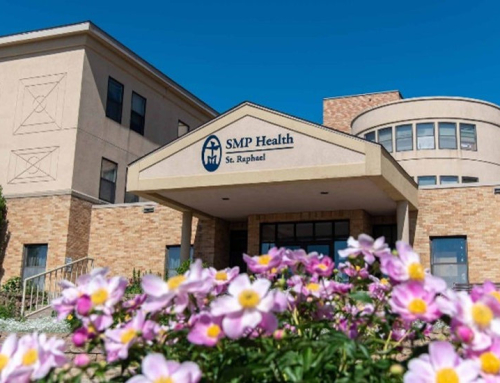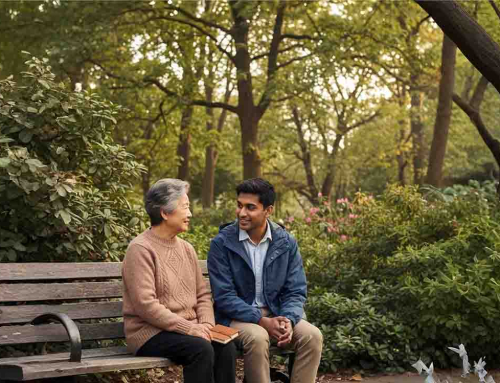Introduction
Too often, we treat social skills as optional extras—something you pick up at school dances, in community recreation, or while learning how to make friends. Cultural awareness, meanwhile, is often framed as trivia—lists of customs, words, or traditions that must be memorized. Emotional skills are sometimes mistaken for personality traits—then we start thinking in the “haves” or have nots”.
This blog invites a shift. Social, cultural, and emotional skills are not extracurricular. They are foundational constructs, shaped by our encounters with others, and they deserve to be recognized as central to how we live, work, and grow together. At Tellegacy, we see how these skills flourish most naturally in intergenerational relationships, where structured encounters become powerful tools for health, connection, and human flourishing..
The Social Construct of Social Skills
Social skills are best understood not as techniques for “making friends” but as daily practices of human connection. In workplaces, clinics, and classrooms, they are what turn transactions into relationships and collaboration into genuine partnership.
Historically, however, “social skills” have been limited in public imagination. As Durlak et al. (2011) noted, social-emotional learning (SEL) programs are often targeted only at school-aged children, as if adults no longer need to refine these skills. Yet research demonstrates that social competencies are lifelong, continuing to shape mental health, employability, and community engagement throughout adulthood (Humphrey, 2013).
When social skills are misunderstood as “recreational,” workplaces risk underestimating their power. Poor interpersonal skills can erode team cohesion, increase burnout, and even compromise patient safety in healthcare settings (Leonard, Graham, & Bonacum, 2004). Conversely, high-functioning teams rely heavily on what might once have been dismissed as “soft skills”: empathy, active listening, conflict resolution, and rapport-building. These skills are not hobbies—they are the fabric of professional and civic life.
Cultural Fluency as Language
Cultural awareness is often described in static terms: learning about traditions, observing holidays, or memorizing dos and don’ts. But genuine cultural fluency is dynamic. It works much like language.
In language learning, fluency is rarely measured by how many words a person knows. What matters is how comfortable someone is using the language in real-world settings—and how comfortable they make others feel in the process. Similarly, cultural fluency is not about memorizing facts but about the ease and respect with which we navigate difference.
This resonates with the Tellegacy program, where students learn cultural humility not from textbooks but from conversations with older adults who carry decades of lived experience.
Just as language learners struggle if their practice is confined to classrooms, those who attempt cultural awareness in isolation risk difficulty when they finally engage in authentic encounters. One can actually learn to be inauthentic. The good news is they can unlearn it as well.
True learning happens within the social construct of everyday life—at the dinner table, in the workplace, and through intergenerational dialogue.
Emotional Skills: Reflection in Action
Emotional skills form a third pillar, often overlooked in professional development. Where social skills emphasize connection and cultural fluency emphasizes respect across difference, emotional skills emphasize self-regulation, reflection, and growth.
The literature is clear: emotional regulation and awareness are central to resilience and well-being (Gross, 2014). Skills like gratitude, mindfulness, and reflective practice are not just internal exercises; they translate directly into how we support others. For example, cultivating gratitude has been linked to improved psychological health, lower aggression, and stronger relationships (Emmons & McCullough, 2003).
Within Tellegacy, emotional skills are intentionally nurtured. Students, known as Legacy Builders, train in mindfulness, gratitude, and reflection before engaging with older adults. These practices help them approach conversations not just with curiosity, but with humility and attentiveness—qualities that enrich both sides of the encounter.
Social, Cultural, and Emotional Skills as Interdependent
Although often discussed separately, social, cultural, and emotional skills function as an interdependent triad. Social connection without cultural awareness risks exclusion. Cultural fluency without emotional intelligence risks superficiality. Emotional skills without social engagement risk becoming self-absorbed exercises.
Together, however, these skills form a robust framework for human flourishing. The World Health Organization (WHO, 1997) emphasized that life skills—including communication, empathy, decision-making, and coping—are critical not only for personal development but also for building healthier societies. In workplaces, these skills have been linked to better teamwork, reduced conflict, and improved leadership effectiveness (Boyatzis, 2018).
Intergenerational Encounters as Natural Classrooms
Perhaps the most powerful setting for these skills to grow is intergenerational engagement. Research consistently shows that structured intergenerational programs reduce loneliness among older adults while improving empathy, communication, and social responsibility among younger participants (Martins et al., 2019).
Tellegacy embodies this approach. Students and older adults engage weekly in structured conversations rooted in reminiscence therapy, mindfulness, and storytelling. The result? Reduced loneliness and depression scores among older adults, and measurable growth in empathy and age-awareness among students. Unlike traditional classrooms, these encounters take place in the living, breathing laboratory of human relationship—where social, cultural, and emotional skills are exercised in real time.
Why This Matters for Workplaces
What does all this mean beyond Tellegacy? It means that organizations—from hospitals to businesses to schools—must stop treating social, cultural, and emotional skills as optional or secondary. They are workplace essentials.
- For healthcare, cultural fluency reduces misdiagnosis, increases patient trust, and improves adherence to treatment (Betancourt et al., 2016).
- For education, social and emotional learning improves academic outcomes and decreases behavioral issues (Durlak et al., 2011).
- For business, emotional intelligence predicts leadership success and employee retention more strongly than IQ (Goleman, 1998).
These outcomes remind us that connection, respect, and reflection are not luxuries. They are professional competencies with measurable outcomes.
Conclusion
Social, cultural, and emotional skills are not add-ons to human life; they are the foundation of it. Misunderstood when framed narrowly as “recreational” or “extracurricular,” these skills in fact shape how we connect, collaborate, and care.
Like language, they are best learned not in isolation but in community. Like muscles, they strengthen with practice and reflection. And like bridges, they carry us across differences, generations, and experiences toward shared humanity.
At Tellegacy, we witness this truth every day. Social, cultural, and emotional skills are not just relevant to dating, recreation, or casual friendship. They are the art of connection itself—the everyday work of building a more compassionate, collaborative, and healthier world.
References
- Betancourt, J. R., Green, A. R., Carrillo, J. E., & Owusu Ananeh-Firempong, I. I. (2016). Defining cultural competence: A practical framework for addressing racial/ethnic disparities in health and health care. Public Health Reports, 118(4), 293–302.
- Boyatzis, R. E. (2018). The competent manager: A model for effective performance. John Wiley & Sons.
- Durlak, J. A., Weissberg, R. P., Dymnicki, A. B., Taylor, R. D., & Schellinger, K. B. (2011). The impact of enhancing students’ social and emotional learning: A meta‐analysis of school‐based universal interventions. Child Development, 82(1), 405–432.
- Emmons, R. A., & McCullough, M. E. (2003). Counting blessings versus burdens: An experimental investigation of gratitude and subjective well-being in daily life. Journal of Personality and Social Psychology, 84(2), 377–389.
- Goleman, D. (1998). Working with emotional intelligence. Bantam Books.
- Gross, J. J. (2014). Emotion regulation: Conceptual and practical issues. In J. J. Gross (Ed.), Handbook of emotion regulation (2nd ed., pp. 3–20). Guilford Press.
- Humphrey, N. (2013). Social and emotional learning: A critical appraisal. Sage.
- Martins, T., Midão, L., Martínez Veiga, S., Dequech, L., Busse, G., Bertram, M., … & Vives, M. (2019). Intergenerational programs review: Study design, characteristics of intervention, outcomes, and effectiveness. Journal of Intergenerational Relationships, 17(1), 93–109.
- World Health Organization. (1997). Life skills education for children and adolescents in schools. Geneva: WHO.
- Holloway, J., Sayeed, O., & Jurivich, D. (2023). Tellegacy: An intergenerational wellness and health promotion project to reduce social isolation and loneliness in older adults: A feasibility study. International Journal of Environmental Research and Public Health, 20(7094), 1–18






